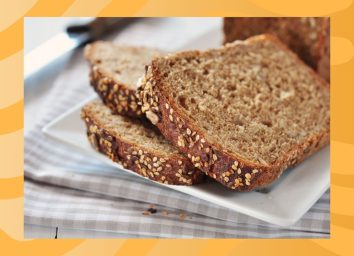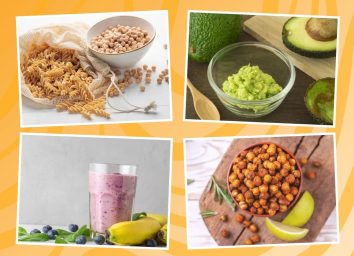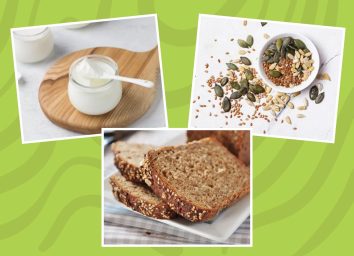16 Easy Ways To Increase Your Protein Intake

The list of benefits of eating protein is quite long, and it's exactly why so many people focus on increasing protein intake and getting enough of this nutrient in their diet. For starters, protein can help satiate your hunger and keep you feeling more full throughout the day, which in turn can help minimize mindless snacking and reduce cravings. This nutrient is also necessary for building lean muscle mass, making it a requirement for seeing results from your workouts. Other benefits include better bone health, boosting metabolism, and helping to manage weight loss.
Even though these benefits are motivating, it can sometimes feel impossible to get enough protein in your daily diet when life and a busy schedule get in the way. This is why it's helpful to make your protein intake as easy as possible so that you can ensure you're meeting your goals even if you feel like you have no time or energy left in your day. For instance, you can make yourself a protein-rich meal with grilled chicken, quinoa, and a salad topped with your favorite ingredients, but this will require a bit more time and effort. Instead, you can get similar levels of protein by preparing a parfait of Greek yogurt, nut butter, seeds, and nuts the night before and keeping it in your fridge ready to go.
If you're interested in learning more simple tips and tricks for effortlessly adding more protein to your day, read on to see what our dietitians recommend. Then, for more helpful eating tips, make sure to check out the 15 Best Vegetarian Sources of Protein.
Add cow's milk to your smoothie.
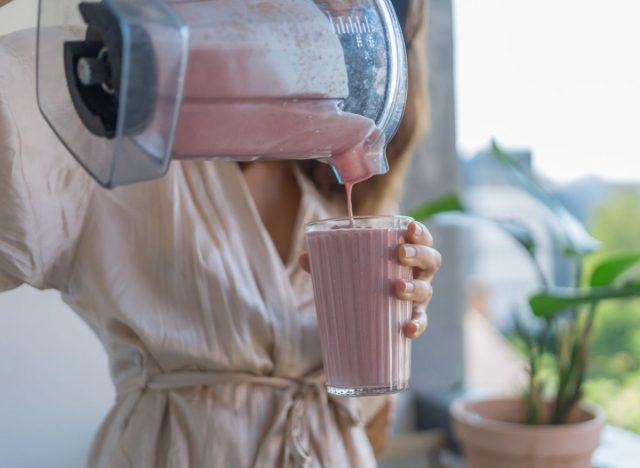
Protein in a cup of whole milk: 8 grams
Making a morning smoothie for breakfast or having one as a mid-afternoon snack can give you plenty of opportunities for packing in fiber and protein with foods like fruit, vegetables, nut butters, seeds, and protein powder. And if you're able to consume dairy products, a great way to get even more protein into your smoothie is by swapping out almond or oat milk with cow's milk as your liquid base.
"Amp up the protein of your smoothie with 8 grams of high-quality protein with 8 ounces of cow's milk," says Amy Goodson, MS, RD, CSSD, LD. "While many reach for water or juice as a smoothie base, cow's milk is a nutrient-rich and affordable solution for protein, and it provides 13 essential nutrients!"
Add protein powder to your oatmeal.
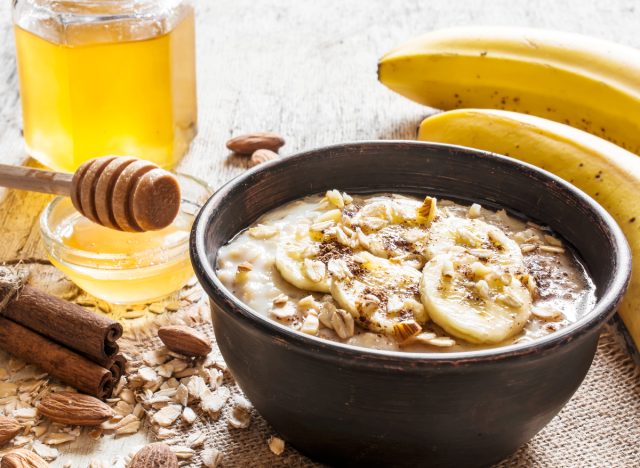
Protein in 2 scoops of standard whey protein powder: 26 grams
One of the best things you can do for your morning is to start it off with a fiber-rich bowl of oatmeal. However, even though you'll get a good amount of fiber to help with your digestive health, you'll want to increase the amount of protein in your breakfast too. This is why Goodson suggests adding a scoop or two of protein powder to your bowl of oats.
"While whole grains contain a few grams of protein, it's not enough," says Goodson. "Adding protein or collagen powder to your oatmeal can help make a low-protein food a well-balanced meal." And another added benefit is that it can add some flavor to your otherwise fairly bland oatmeal.
Snack on beef jerky.
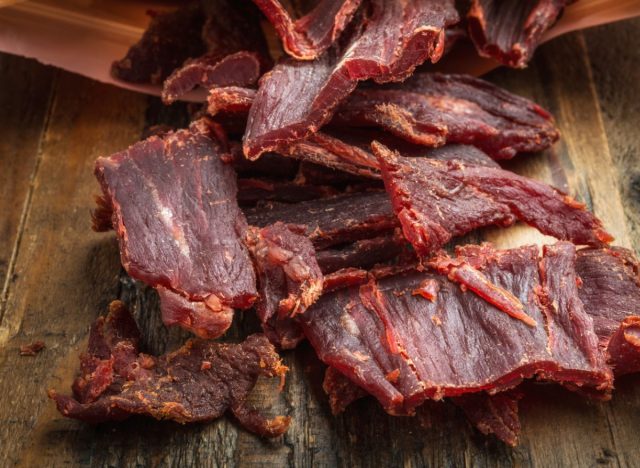
Protein per ounce of standard beef jerky: 9.4 grams
If you find it hard to reach your protein goals throughout the day, you're not alone. When you're running around and trying to keep up with a busy schedule, it can be hard to find time for a snack, let alone a healthy, nutrient-rich snack. If this is often an issue you run into, Goodson suggests keeping some non-perishable snacks on hand for when you're in need of a bite.
"Many proteins have to be kept hot or cold, making them less convenient for 'on-the-go,'" says Goodson. "However, beef jerky is a shelf-stable protein that you can throw in a desk, gym bag, or purse. This is an easy way to get protein in a hurry without the risk of food safety issues. Plus, beef provides 10 essential nutrients, so it is a fantastic protein at snack time."
Add more eggs to your day.

Protein per large egg: 6.2 grams
"Many people think of eggs at breakfast, but eggs can help power your whole day with protein," says Goodson. "Hard-boiled eggs are a great solution for adding nutrients to snack time and you can add fried eggs to salads, bowls, or even burgers."
Not only do eggs provide around 6 grams of protein each, but Goodson adds that they "boast of many other nutrients like iron, choline, and vitamin B12."
Get creative with Greek yogurt.
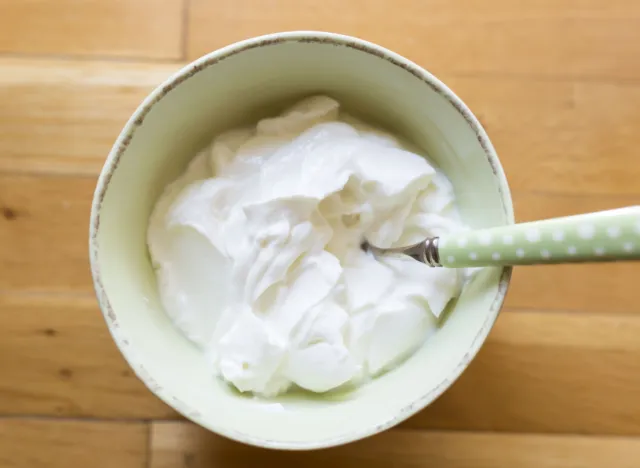
Protein per small container of low-fat Greek yogurt: 19.9 grams
Greek yogurt has more protein than your standard cup of regular yogurt, and if you stick with a low-fat variety without too many added sugars, it can be a healthy, convenient option for getting more of this nutrient in your day. Not only that, but this is a highly versatile food if you know how to use it!
"Yes, you can make a yogurt parfait with Greek yogurt, but it can also be a topping for whole grain waffles, the base for salad dressings and dips, a swap for different ingredients in baked goods, blended into a smoothie instead of protein powder, and can be the base for desserts like fruit, peanut butter, and dark chocolate chips, whole grain granola, and more," says Goodson.
Swap quinoa for rice.
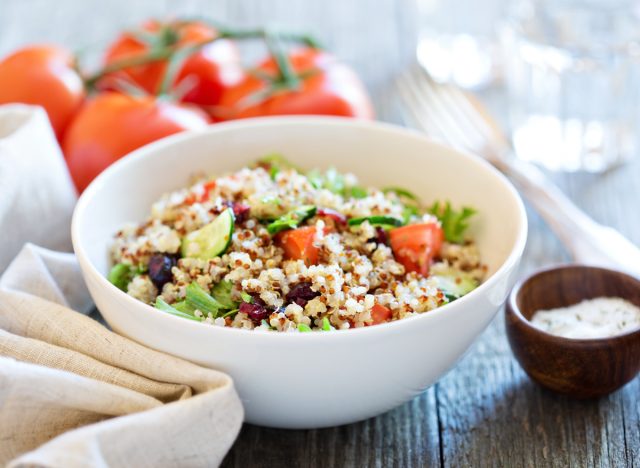
Protein per cup of quinoa: 8.1 grams
A bowl of rice can be a comforting base for many meals, but according to Trista Best, MPH, RD, LD at Balance One Supplements, swapping your rice out for quinoa can give you an easy protein boost without changing the nature of your meal too drastically.
One cup of white rice contains about 4.4 grams of protein, whereas a cup of quinoa contains about 8 grams. "This difference can be significant, and incorporating quinoa into your diet can provide a plant-based alternative that offers all nine essential amino acids, making it a complete protein source," says Best.
Eating complete protein sources is important because out of the 20 amino acids our body needs to function, only 11 can be made by the body on its own, with the remaining nine needing to come from food sources. Most plant-based proteins are incomplete, meaning they contain some amino acids but not all nine, and animal sources are considered complete, meaning they have all nine. However, quinoa is special because it contains nine amino acids even though it's a plant.
Snack on roasted chickpeas.
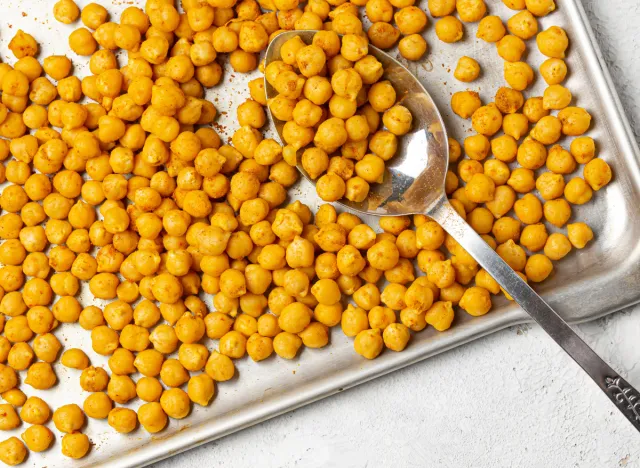
Protein per cup of chickpeas: 11.8 grams
Sometimes you're just craving something crunchy and salty to snack on, and oftentimes things like chips, pretzels, or popcorn can satisfy these cravings. But if you want to get more protein in an easy, satisfying way, Best suggests swapping these snacks out for some roasted chickpeas instead.
"By choosing chickpeas as a snack, you can enjoy a protein-rich option that also delivers essential minerals and dietary fiber, contributing to a more balanced and nutritious snack choice," says Best. "Incorporating roasted chickpeas into your diet can also support satiety and help meet your daily nutrient needs."
Use cottage cheese
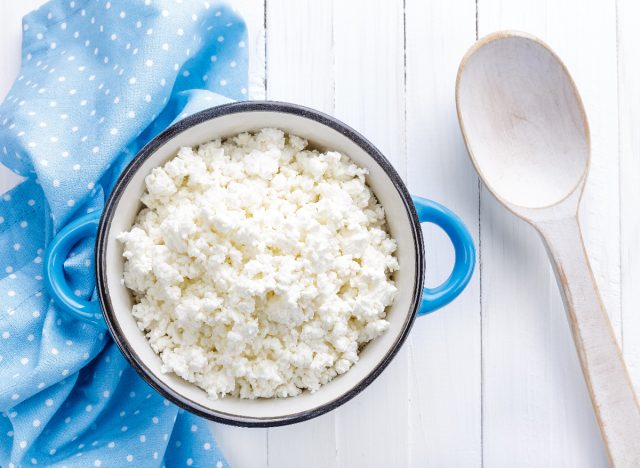
Protein per 4 ounces of 1% cottage cheese: 14 grams
Cottage cheese has taken the internet by storm—and for good reason, too. This lower-fat cheese is packed full of protein and is so versatile that you can use it in both sweet and savory recipes, and you can also "swap it in for plain yogurt in things like dips and smoothies," says Elizabeth Ward, MS, RDN, co-author of The Menopause Diet Plan, A Natural Guide to Hormones, Health, and Happiness. And if you're feeling even more creative, you can hop on the viral food trend of making cottage cheese ice cream!
Choose soy instead of almond
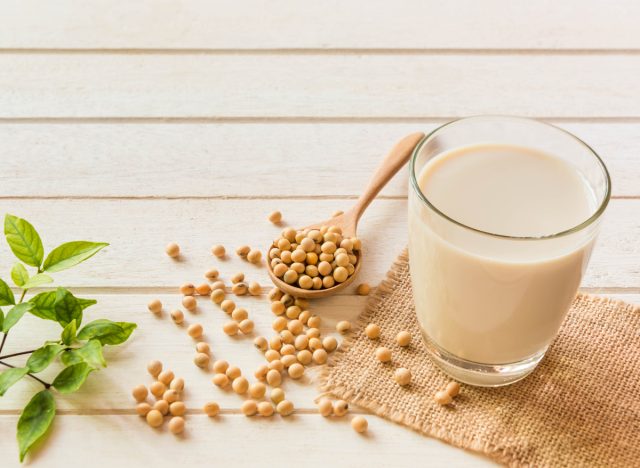
Protein per serving of soy milk: 8 grams
Soy milk isn't for everyone, as some people may be trying to limit the amount they consume if they're experiencing stomach discomfort or digestive issues. But if you're fine consuming soy products, Ward recommends swapping almond milk for soy when going for non-dairy options.
Drink one cup of soy milk instead of almond milk to get about seven additional grams of protein," says Ward. "It may come as a surprise, but almond milk unfortunately has almost none."
Substitute pistachios for pecans.
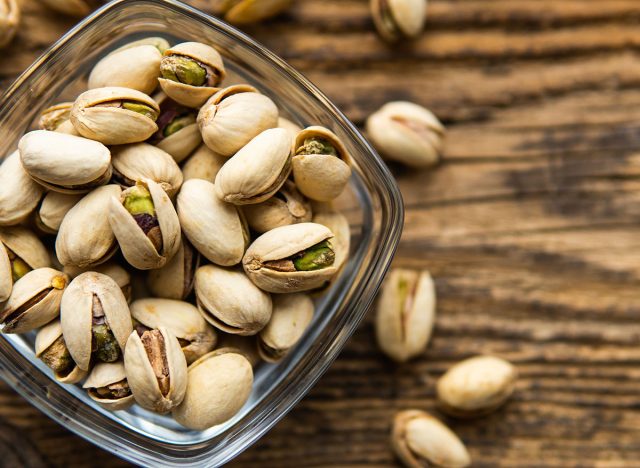
Protein per ounce of pistachios: 5.7 grams
Another easy protein swap that you may not be aware of is switching your pecans for pistachios. You'll get about 2.5 grams of protein in an ounce of pecans, but you'll get about 5.7 in an ounce of pistachios. "Plus, the protein in pistachios is complete, which means it provides all the essential amino acids to support growth and is the same as the high-quality type found in animal foods," says Ward.
Eat edamame.
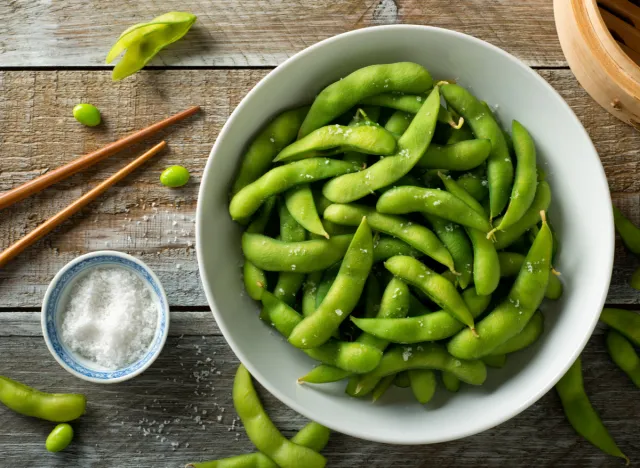
Protein per cup of edamame: 18.4 grams
You may only think of edamame as an appetizer at your favorite sushi restaurant, but this vegetable can be eaten as a high-protein snack to help you meat your goals throughout the day.
"For more protein, munch on roasted edamame instead of snacks like pretzels," says Ward. She also adds that along with this specific nutrient boost, "edamame has phytonutrients that support health." Phytonutrients—also known as antioxidants—are plant compounds found in fruits and vegetables and are associated with benefits like reduced risk of heart disease and other chronic illnesses.
Add protein powder to my pancake or waffle mix.

Protein in 2 scoops of standard whey protein powder: 26 grams
Another trick for getting more protein is to take your usual pancake mix and add in a scoop or two of your favorite protein powder.
"Waffles and pancakes are typically very low in protein, which makes it difficult to get a good serving of protein in if you decide to have these for a meal," says Jesse Feder, RDN, CPT at My Crohns and Colitis Team. "But adding in protein powder to the waffle or pancake mix is a great way to add some extra flavor and a significant amount of protein to the meal.
Add legumes such as chickpeas or beans to your rice.
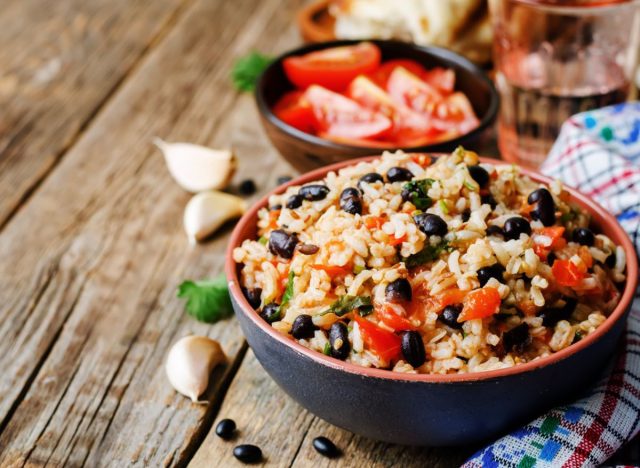
Protein per half cup of black beans: 7.25 grams
"If you are having a dish that is low in protein and high in carbohydrates such as rice, I recommend adding in some legumes," says Feder. This includes things like chickpeas, black beans, lima beans, or peas.
"Legumes will add in a good portion of protein to your meal, and additionally, legumes and rice together often make for a complete protein source containing all 9 essential amino acids."
Eat whole grain pasta instead of refined.
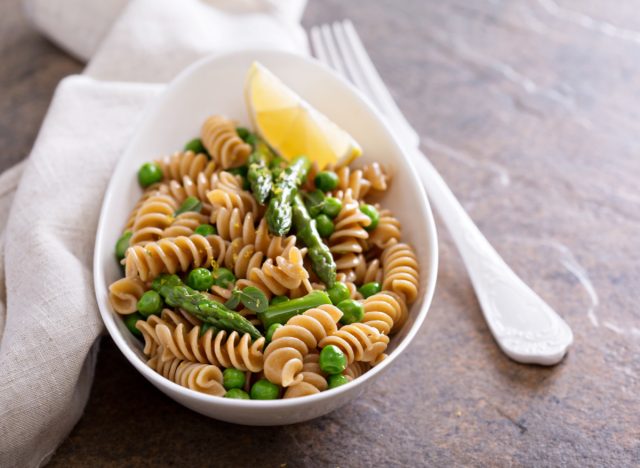
Protein per cup of whole grain spaghetti: 8.8 grams
Sometimes you just need a cozy bowl of your favorite pasta, cooked with all of your favorite ingredients. But if you're using regular white flour pasta, you'll be missing out on an opportunity to effortlessly add more nutrients.
"You can make simple swaps that make a big difference, like replacing refined grains (like white rice and pasta) with their whole-grain counterparts such as brown rice or whole wheat pasta," says Catherine Gervacio, RD, nutrition writer for Living.Fit. "These options contain more protein and provide additional fiber and nutrients, contributing to a well-rounded diet."
Add Tofu as a smoothie thickener.
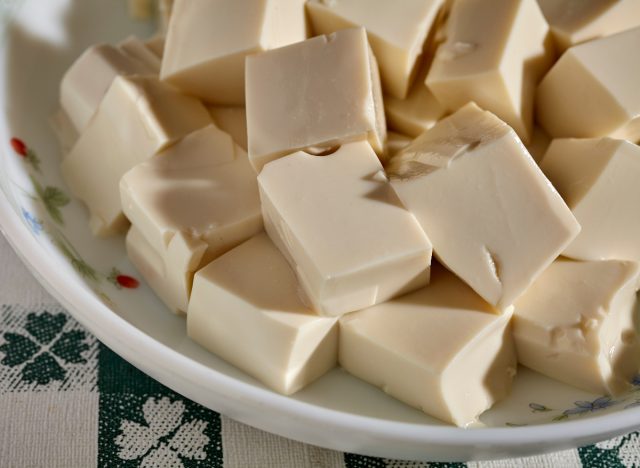
Protein per 2 ounces of tofu: 3.5 grams
Using tofu in your smoothie can provide a thicker, creamier texture, as well as give you a small boost of protein. At first glance, it may not seem like 3.5 grams of this nutrient is a lot, but when this is added to a smoothie that already contains protein-heavy ingredients like chia seeds, nut butters, and whole milk, it can contribute a well-rounded, satiating beverage.
On top of that, tofu is also considered a plant-based complete protein source, meaning it provides all nine of the essential amino acids your body can't make on its own.
Use tahini as a salad dressing base
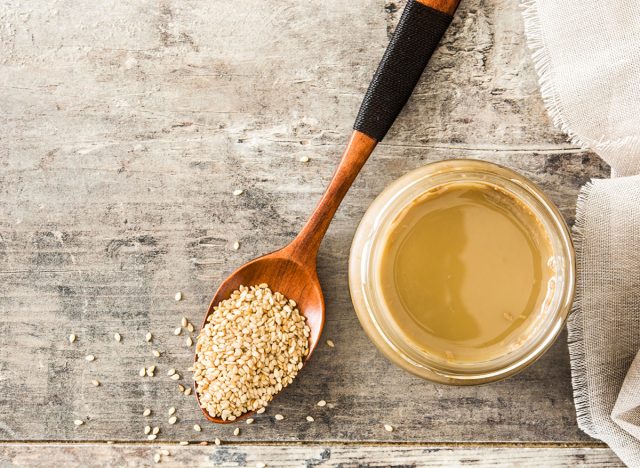
Protein per 2 tablespoons of tahini: 5.1 grams
Made from ground sesame seeds, tahini is a flavorful, nutty, creamy base you can use for dips, baked goods, and salad dressings. And if you use tahini as a base in one of your recipes, you'll be giving your body an extra 5 grams of protein per two tablespoons.
Along with extra protein, tahini will give you a friendly dose of calcium, magnesium, manganese, folate, vitamin B12, and vitamin B6.
- Source: https://pubmed.ncbi.nlm.nih.gov/22958314/
- Source: https://pubmed.ncbi.nlm.nih.gov/15466943/
- Source: https://fdc.nal.usda.gov/fdc-app.html#/food-details/173167/nutrients
- Source: https://fdc.nal.usda.gov/fdc-app.html#/food-details/167536/nutrients
- Source: https://fdc.nal.usda.gov/fdc-app.html#/food-details/748967/nutrients
- Source: https://fdc.nal.usda.gov/fdc-app.html#/food-details/170903/nutrients
- Source: https://fdc.nal.usda.gov/fdc-app.html#/food-details/168917/nutrients
- Source: https://fdc.nal.usda.gov/fdc-app.html#/food-details/168930/nutrients
- Source: https://fdc.nal.usda.gov/fdc-app.html#/food-details/175206/nutrients
- Source: https://fdc.nal.usda.gov/fdc-app.html#/food-details/173417/nutrients
- Source: https://www.nccih.nih.gov/health/soy#:~:text=In%20research%20studies%2C%20soy%20protein,such%20as%20constipation%20and%20diarrhea.
- Source: https://fdc.nal.usda.gov/fdc-app.html#/food-details/170184/nutrients
- Source: https://fdc.nal.usda.gov/fdc-app.html#/food-details/170182/nutrients
- Source: https://fdc.nal.usda.gov/fdc-app.html#/food-details/168411/nutrients
- Source: https://www.health.harvard.edu/blog/phytonutrients-paint-your-plate-with-the-colors-of-the-rainbow-2019042516501
- Source: https://fdc.nal.usda.gov/fdc-app.html#/food-details/173167/nutrients
- Source: https://fdc.nal.usda.gov/fdc-app.html#/food-details/175188/nutrients
- Source: https://fdc.nal.usda.gov/fdc-app.html#/food-details/168916/nutrients
- Source: https://fdc.nal.usda.gov/fdc-app.html#/food-details/173787/nutrients
- Source: https://fdc.nal.usda.gov/fdc-app.html#/food-details/173787/nutrients

